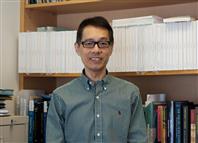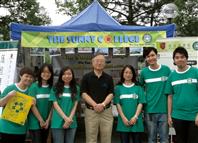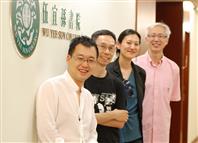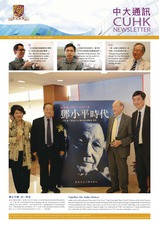This September, college education on our campus will be given a new spin when Wu Yee Sun College admits its first cohort of over 310 students.
With ‘Scholarship and Perseverance’ as its motto, Wu Yee Sun College and Wu Yee Sun Foundation expect students to possess breadth of knowledge and of vision, and to be hardy and persistent. The mission of the College is to instill in students an ‘entrepreneurial spirit with social responsibility’. Master of the College Prof. Rance P.L. Lee explained, ‘What this world needs most is innovation; sincerity and passion often are the keys to success. Just look at Steve Jobs of Apple, Prof. Charles K. Kao, former Vice-Chancellor of CUHK, and the late Prof. Hu Shiu-ying who passed away not long ago. It’s only by becoming completely involved and daring to innovate that you progress.’ He stressed that both people and corporations must honour their social responsibility. These qualities are of course included in the mission of a College whose duty is to nurture the young.
He explained that having an ‘entrepreneurial spirit’ is not about teaching students to become entrepreneurs so they can make money. It implies equipping them with direction, purpose and the ability to become involved. They must have the vision, purpose, creativity and passion of an entrepreneur or a corporate leader. These qualities can be applied to anything. Having an entrepreneurial spirit is about themselves. Being socially responsible is about others. They have to build up themselves in order to be responsible for society. The two are complementary.
General Education Taught by Four Professors
The College’s formal and informal education activities are designed to fulfill the vision of ‘entrepreneurial spirit with social responsibility’. Prof. Sunny K.S. Kwong, Dean of General Education, said, ‘The College’s general education course is an example of innovation. We divide the students into two groups with about 160 each. The two groups attend the three-credit course, “entrepreneurial spirit and social responsibility” in first and second terms of Year 1, respectively. The course aims at providing the same learning experiences for students and in doing so, boosts college spirit.
‘The course has four components, namely, (1) individual, society and university; (2) social problems and issues; (3) innovations, social welfare, and social ventures in a market economy; (4) the psychology of thinking and creativity. Each component is taught by a teacher from the Faculty of Social Science. The course starts with individuals. Prof. Chow Po-chung of the Department of Government and Public Administration will guide the students to understand their roles, their respective social responsibilities, and their relationships with society.’
After the self-reflection exercise, Prof. Rance Lee will introduce them to a wide range of social and environmental issues. Then Professor Kwong will discuss the market economy and its operations, and how the economic value of innovations helps to promote humanity and social progress. This will be followed by insights drawn from the psychology of thinking and creativity, and learning to recognize one’s own creativity and talent, taught by Prof. Louis N.Y.Lee, Dean of Students. Each professor will teach three lessons (one per week) and the last lesson will be hosted by all four together with a wrap-up discussion with the students.
From Theory to Practice
Apart from the course, the College also offers non-credit bearing college assemblies, forums and lectures. Distinguished speakers from the public sector and the innovative business sector are invited to share their experiences with the students. In Year 4, students are required to take another three-credit course, ‘college senior seminar’, to put into practice what they have learnt. Under the supervision of a teacher, they will form small teams to work on an innovative project that will bring social benefits to the community, e.g., wholesaling vegetables of organic farms to the University.
Inspiring Creativeness with Creativity
In addition to informal education activities such as exchange, service learning and mentorship programmes, the highlight is surely the first Creativity Laboratory in local universities which is designed to inspire students’ creativity through ‘playing’.
Prof. Louis Lee joined hands with Prof. Chu Ming-chung of the Department of Physics, Mr. Bernard Y.S. Suen of the Centre for Entrepreneurship, and Prof. Marisa K.S. Yiu of the School of Architecture in designing this laboratory. Prof. Louis Lee said, ‘Students love to play in primary and secondary schools. But in college, they only study.’ Professor Chu agreed, ‘I’ve been teaching for about 20 years. I found students are more rigid and stern nowadays. All they care about are examinations and grades. Their vibrant force seems to have diminished.’
Prof. Louis Lee said, ‘The laboratory is set up to inspire student’s creativeness and to provide them with a spacious environment and facilities to explore their ideas and develop their creativity through serious “play” without any pressure to succeed.’
The Universal Design of the Creativity Lab
So what’s inside the laboratory? How does it attract students to come and ‘play’? Mr. Suen pointed that a survey had been done on the design and facilities of the laboratory. Results gathered are multifarious including using it for rest, study, karaoke…, etc. He said, ‘As our students come from different disciplines, we cannot prematurely define how each part of the space should be used. However, the space is going to be very adaptable.’
Professor Yiu illustrated by giving an example, ‘The table is not only used for discussion and workshop, but also for cooking class. We plan to create a series of themes, e.g., sustainability vs urban environment, for students to work on. We’ve come up with some topics and will collect ideas in the coming six months to help formulate the design of the laboratory.’
Catch a Glimpse of the Lab
Mr. Suen said a virtual Creativity Laboratory will be launched in this summer to give students an idea of what it is. And they will be encouraged to give ideas for the final design, and will be informed of updates online. ‘We’re planning to install a camera in the laboratory to take snapshots every 15 minutes around the clock and the images will then be uploaded for viewing. Students’ messages from the board of the virtual laboratory will also be projected on the real laboratory, thus helping to promote interactive communication.’ 




































































































































































Social Bookmarks